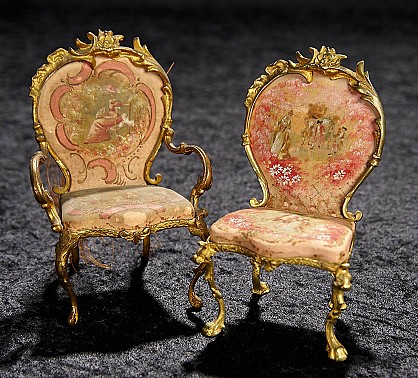Rare French Bisque Poupee, Antoine Edmond Rochard, Stanhope-Jeweled Necklace
Lot #17
30" (76 cm.) Bisque swivel head with flat-cut neck on corresponding bisque shoulderplate, cobalt blue glass inset eyes, dark eyeliner, delicately-painted lashes and brows, accented nostrils, closed mouth excepting a very small opening between the outlined lips, pierced ears, early blonde human hair with interwoven braids and coronet, kid poupee body with gusset-jointing, stitched and separated fingers, lovely antique silk costume. The shoulderplate is decorated with a splendidly painted gold necklace that is comprised of an elaborate gold chain with interspersed gilt circles serving as frames for the glass domed Stanhope images within. The head is designed with a semi-circular cut-out at the back of the head, an oval cut-out at the back shoulderplate and the tiny mouth opening, all designed for illumination when viewing the Stanhope images. Condition: generally excellent. Comments: Antoine Edmund Rochard, circa 1868. Value Points: this example, a grand 30", is superbly preserved, retaining 24 of the original 28 micro-photographs including the Pavillon d'Orleans at Fontainbleau, Vue Generale de la Louvre, the Port of Havre, Ste Chapelle, Hotel de Ville of Paris, Etablissement Thermal, Bassin du Commerce Theatres, St. Jean Baptiste, and notably, an image titled Le Vengeur which may be a coded reference to a journal, Le Vengeur, which appeared in Paris during the 1870 uprising. As an historical dimensional document in doll, photography, and social history, the doll is immensely important. As a work of art, the doll is, in a word, splendid. Historical Background: Rochard, born in 1836 in Paris, the godson of jewelry maker, Barthelemy Legentil with whom he likely apprenticed, was intrigued, not only by jewelry design, but also by micro-photography. In 1868 he deposed a design concerning a system for placing Stanhopes (micro-photographs) in the breastplate and throat of a doll. His logic was simple: the tiny, tiny micro-photographs (about 1-1.4 mm) were to be incorporated with an optical viewing lens which magnified the image about 160 times, making them visible when held closely to the eye. The system was inventive (possibly spurred by the creative fever that swept France during the 1867 International Exposition), but also very costly and time-laborious, and likely the victim of the 1870 Franco-Prussian war and ensuing revolution which devastated Paris. Whatever the reason, or just the simple fact that, once a doll was assembled with a body, light could not enter the shoulderplate and the views could not be seen, few examples of the doll were ever made, accounting for its extreme rarity.
































































































































































































































































































































































































































































































